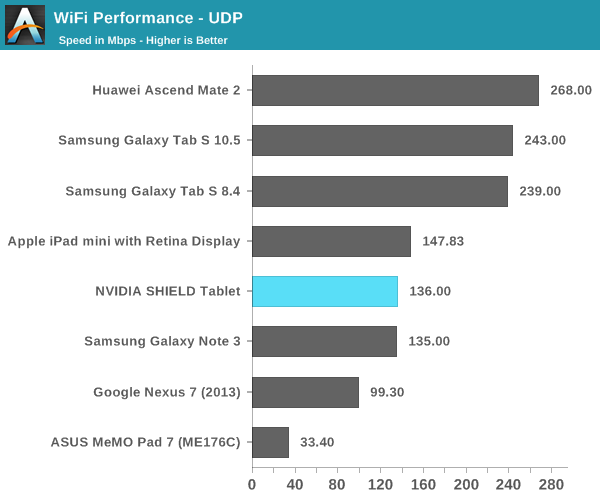The NVIDIA SHIELD Tablet Review
by Joshua Ho on July 29, 2014 9:00 AM ESTWiFi Performance
For the most part these days it seems that the situation for WiFi is much better in mobile than it is anywhere else, but it's still important to test throughput, especially on a device like the Shield tablet that requires low latency, high bandwidth connections in order to support GameStream and GRID. To this end, while NVIDIA hasn't shipped 802.11ac the Shield tablet ships with a 2x2 antenna configuration for a maximum PHY rate of 300 Mbps. Like the Shield portable, this is a BCM43241 chip, likely shared to improve economies of scale. To look at how it performs, we turn to iperf. Before we get into the results of the test, I'd like to thank ASUS for providing the RT-AC68U router to test WiFi perfomance.

Surprisingly, the Shield tablet performs about as well as some single stream 802.11ac solutions like the one found in the Galaxy Note 3. Performance is generally in line with what we'd expect for such a solution, although it would be nice to see 802.11ac for future products.
Camera
While I currently don't have the means to properly test camera, there are still some things to talk about for camera. Both the front and rear camera modules use OmniVision's OVT5963 sensor, which appears to be a 1/4", 5MP sensor. The rear camera has an F/2.0 aperture with 2.95mm focal length, and the front camera has an F/2.8 aperture, with a claimed 4.76mm focal length, although the field of view appears to be somewhat wider. This is the same sensor as the camera in the Nexus 7 (2013). As a rear facing camera, the quality is nothing special but as a front facing camera it's surprisingly high quality. The photo above is with the rear facing camera, the photo below is from the front facing camera. The stock camera application also doesn't show the correct aspect ratio for the camera, so the preview is cropped.
Audio
While I don't have the equipment available to test audio quality and peak volume quite yet, subjectively the two bass reflex ports and dual front facing speakers make for a great experience. It's definitely a major advantage over other devices when it comes to watching movies and playing games as I don't have to cup my hand around the speaker. The larger size of the tablet formfactor means that the stereo separation is much more obvious. On the headphone jack, the device appears to be using a Realtek RT5639 codec. It seems that NVIDIA has continued to use their own speaker protection system that runs on the SoC, as there isn't any clear evidence of a speaker protection IC connected via I2C.












174 Comments
View All Comments
SpartyOn - Tuesday, July 29, 2014 - link
I guess it depends on your setup or what steps you're willing to take. I have an Asus Z77 wifi mobo so I use the Asus Wifi Go app a lot, which allows me remote desktop access and mirroring in an easy package. Haven't invested in a Bluetooth mouse or keyboard, but using USB OTG has worked out just fine for times I've hooked the Shield up to a monitor with M&K.I've done some video editing in Adobe Premiere remotely this way, along with working with Excel files, so I'd say it can actually do work just fine. Does it require some additional cables/accessories to maximize that professional potential? Sure, but then again, I'm not going to be doing any serious work on an 8" Shield tablet without hooking it up to a monitor as well.
fivefeet8 - Tuesday, July 29, 2014 - link
Much of the activities I do require me to be away from the home so a shield with a gamepad attached to the screen would be a bit awkward. The tablet fits more with my requirements.SpartyOn - Tuesday, July 29, 2014 - link
I think there's room for both devices for those that buy into the Nvidia brand and who understand/utilize the gaming features; however, the tablet space is a very competitive market for Nvidia to try and enter, with numerous players, especially for work and professional devices.An additional thought on the gaming side, since this really is the target audience: Does it pass the eye test? If I'm a gamer, and I see someone with a 1st gen Shield, I immediately know that it's a gaming device and might inquire what it is. I also can look at pics when shopping and know that it's a gaming device. If I see someone using the 2nd gen Shield, I just see another tablet out in the wild and when shopping online, it would have to come down to specs/features comparisons.
I guess the overall point I'm trying to make is this: the original Shield was so insanely different that over time it had a chance to succeed, especially with yearly refreshes. Now it's just another tablet that can't even stand up on its own (literally and figuratively) ... how do I balance a tablet in bed or on the couch (or in a plane, train, car?!) when I have to fiddle with a controller and the screen itself. Seems cumbersome for gaming to me and in my opinion actually makes you MORE tethered to a stationary external monitor/HDTV instead of the handheld.
fivefeet8 - Tuesday, July 29, 2014 - link
If there is enough demand for another Shield1 type device, then you may yet see it, but from what's been gathered, there wasn't. Although I do find it also an interesting device, the gamepad agnostic nature of the Tablet gives a better experience with 3rd party pads. Some of which are attachable albeit a bit weight slanted. And it gives console mode an advantage of not having to use another controller.aamir147 - Tuesday, July 29, 2014 - link
I believe the tablet is just another addition to the shield family, this is not to replace the shield portable. This is what the mod in the nvidia blog said.savagemike - Tuesday, July 29, 2014 - link
It would be trivial to make a frame to hold the tablet and controller together for use as you'd like. Meanwhile I was never attracted to the first Shield because gaming is not my number 1 interest - just something that would be a nice bonus.What I'm saying is this more modular approach could easily be made to work as the original Shield but the original Shield cannot be made to work as a stand-alone tablet. So for me this is a much better design.
Especially with the advent of 3d printing. It will only take one clever person to design something to hold the tablet and controller together to mimic the original. If you don't see it pop up soon for easy purchase then it isn't that wanted as it would be simple to do.
Knowname - Wednesday, July 30, 2014 - link
I think you should consider the directstylus modes. I'm sure the wife (if the tablet isn't too heavy) would love that. lus she could read and do other tablet stuffs... if she can get around the horribly dull screen ofc.schizoide - Tuesday, July 29, 2014 - link
You can pick up a refurb Nexus 7 (2013) for $140 from an authorized seller on eBay, or $230 full price and new. The shield tablet costs $300. What do you get for twice the money?From a tablet perspective:
- Slightly larger, but lower quality screen
- Stylus
- Dramatically improved speakers
- 28% heavier
- Maybe slightly snappier? Much faster in benchmarks, but the Nexus 7 2013 is fine for browsing and tablet stuff. I haven't seen anyone compare them in interactive use.
From a gaming perspective:
- Shadowplay, if you have a nVidia GPU in your gaming box and want to plug a tablet into your TV. Better off getting a haswell chromebox and installing steam for linux on it.
- Grid streaming, if you're in northern california.
- A couple Tegrazone games, primarily 10 year old PC ports.
- All the android games built for the lowest common denominator that play on your Aunt's Galaxy S2 will play here too.
In my opinion, the Shield tablet doesn't make a lot of sense as a tablet or as a gaming device. If it was priced competitively with the new Nexus 7, then certainly it would be interesting. If you want to buy a small android tablet and don't care about the $70 (or $160 for the refurb!) I guess go crazy. But will they sell a lot of them? No way.
Now if nVidia could get something like their GTX 860M and crunch it down to fit in a tablet TDP, and slotted it in alongside an atom CPU for a tablet running real Windows, with its massive software library, that could be truly attractive.
ams23 - Tuesday, July 29, 2014 - link
Shield tablet is already #5 in the Amazon.com best sellers list for tablets: http://www.amazon.com/Best-Sellers-Electronics-Com...Nexus 7 is a great tablet too, but the difference in SoC performance is quite large. Shield tablet has 2x higher CPU performance and 3x higher GPU performance in comparison, with a much more modern GPU too.
Note that many of the people getting the Shield tablet are upgrading from the original Nexus 7 tablet, so the difference for these people will be like night and day.
schizoide - Tuesday, July 29, 2014 - link
Yeah, it's beating the ipad air and mini. It just came out. You think that'll hold up?